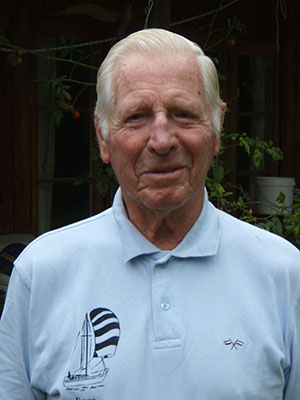
Sept 2015: Derry has been heavily involved in local marine ecology during the course of his teaching career. He was part of two previous attempts to set up a marine reserve in the Bay. He's pleased to be involved in Fish Forever and the team is delighted to be able to draw on his historical experience. Derry is known locally for teaching many people in the Bay of Islands to sail.
What was it that enticed you into the world of conservation?
When I was five I remember the joy of seeing insects and other animals under stones and logs. At secondary school in Shropshire we had a wonderful biology teacher who gave up weekends regularly to take us out cycling to study the ecology of bogs, swamps, lakes and forests. His enthusiasm made us appreciate the fascination of these ‘natural’ areas that were of no apparent value to humans yet were essential providers of balance to the surrounding agricultural and urban areas. Doing a Forestry / Botany degree at Oxford cemented this interest with a huge emphasis on ecology and the derived conservation aspects.
You’re a former science teacher, Derry. Can you tell us a bit about your teaching experiences in the Bay of Islands? Isabella and I arrived in the Bay of Islands in 1974 with our daughter (9) and son (5). I got a job as HOD science at Kerikeri High School, having been teaching at Papatoetoe. I particularly enjoyed teaching senior biology with the project activities making up 20% of the internal assessment and allowing us to have fun investigating a very wide range of topics. A highlight was working on Kina at a couple of sites at Tapuaetahi where we set out quadrats in 3-5 m of water. We also experimented with tagging and releasing Kina to do population counts. Really enjoyable! Other topics ranged from rocky shore studies, through mangroves, mud crabs, shrimps, sea anemones; the labs were full of seawater aquariums. Fresh water was studied in the stream behind the primary school. In those days we were able to use electric current sampling, finding up to 60 ‘bootlace’ eels per metre quadrat. We also did projects on red-billed gulls, sparrows, [nesting boxes in the lab windows], soil organisms, worms,
Isabella and I arrived in the Bay of Islands in 1974 with our daughter (9) and son (5). I got a job as HOD science at Kerikeri High School, having been teaching at Papatoetoe. I particularly enjoyed teaching senior biology with the project activities making up 20% of the internal assessment and allowing us to have fun investigating a very wide range of topics. A highlight was working on Kina at a couple of sites at Tapuaetahi where we set out quadrats in 3-5 m of water. We also experimented with tagging and releasing Kina to do population counts. Really enjoyable! Other topics ranged from rocky shore studies, through mangroves, mud crabs, shrimps, sea anemones; the labs were full of seawater aquariums. Fresh water was studied in the stream behind the primary school. In those days we were able to use electric current sampling, finding up to 60 ‘bootlace’ eels per metre quadrat. We also did projects on red-billed gulls, sparrows, [nesting boxes in the lab windows], soil organisms, worms,
slaters, snails, etc. Plants were not forgotten; we had great access to a bush reserve off Onewhero road as well as parts of Puketi. Our biology garden had a large plastic house, timed watering etc.
What do you most love about being here? What are your favourite parts of the Bay of Islands and why?
We came to the Bay of Islands after spending seven years in Auckland – it was either Nelson or the Bay of Islands as our most preferred place to live and bring up our children. I have always been keen on boats, particularly sailing and the Bay is a wonderful sailing environment for boating. I was also keen on diving and the Bay had wonderful diving experiences to offer and still has to a lesser extent. We make use of the bush areas and enjoy the bird life. Having a Kiwi calling in our garden and Kereru feeding on our berries is a definite bonus.
In the bay itself we particularly enjoy the Te Pahi islands, Black Rocks and Okahu. The first for the very interesting beaches, rocky environments, and clear evidence of Maori habitation. The Black Rocks for diving, watching fish and exploring the unique micro-environments with their small animals and large birds. Okahu gives us a feeling of being less heavily ‘used’ than other islands and is changing / developing so rapidly that it is exciting to observe. The water is still quite clear for diving there at times.
What changes have you seen in your lifetime?
Water quality / clarity, up to the 80s we could generally see the sandy bottom almost all the way from southwest Moturua to Otehei bay. We often saw dolphins swimming close enough to the bottom to see them stirring up the clean white sand. I guess this is largely due to on shore development without enough control over reducing erosion?
We never used air bottles to gather kai moana. We could always get a feed of scallops for example in many parts of the Bay. In the last 10 years we are finding old scallop beds gone and current ones very impoverished. This is obviously partly due to increased population.
Our fishing methods have been pretty standard over the last 40 years. We have a standard trolling system white lure and hand line which would always catch us a Kahawai supper until they were put on the commercial fishing quota. After that they became very few and far between. Recently there has been a very slight recovery. In the same vein we used to have a school coastal cruise every year from 1975 till 1990. On our way back virtually every boat, up to 5 to 10 in the fleet, would catch a Kingfish for the crew’s supper on the way back into the bay while passing Bird Rock.
Until 8 years ago there were always large shoals of Tarakihi, Blue Maomao, Parore, etc. around Cape Brett and Nine Pin. The shoals when they are there are a bare shadow of themselves.
Derry, you have been involved in previous efforts to protect areas of the Bay of Islands in marine reserves. What can you tell us about that?
My memory of the earlier marine reserve applications has become a bit woolly. I do recall that the second, more determined effort that involved DOC staff and many Kerikeri High School staff

and friends. We had a huge response from the community: 96% support from over 600 responses out of 1000 hard copy distributions. This was in the 1980s. There was less technology then. We had a meeting in the School Hall at which 320 people turned up to hear Professor Bill Ballantine speak. We put in a formal application to the Minister but were eventually told by the DoC manager at Russell, after regular enquiries monthly over 6 months, that he did not support our application as there had not been sufficient consultation. Things have changed a lot since then. There was much less fragmentation at that time and I have no memory of a strong fishing lobby. I am sure we were ready for a marine reserve at the time and I think the community is ready now as much as then, but there seems to be more opposition.
You were awarded an MNZN (Member of the New Zealand Order of Merit) in 2009 for your work in youth sailing – there must be a connection for you between this outdoor activity and a love of the natural environment?
Yes I think sailing is a moderately environmentally-friendly sport; at least in some forms. Being out on the water in the bay allows me to see many of the conservation trends. Dealing with young sailors keeps one’s eye on the future…
